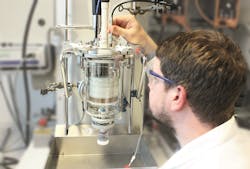Photon density wave spectroscopy performs real-time paint/varnish analysis
By teaming up with PDW Analytics (Potsdam, Germany), Fraunhofer Institute for Applied Polymer Research (Fraunhofer IAP; Potsdam-Golm, Germany) scientists are able to monitor the production of paints, varnishes, and adhesives continuously and in real time--allowing them to design more efficient processes.
While high-quality, expensive paints have excellent coverage, bargain products allow the old, colored coat of paint to shimmer through. The material properties of wall paint depend to a large extent on the size of the particles it contains; for example, filler material, bonding agents, pigments, or additives. That is why, when developing new paints, manufacturers want to know precisely what goes on in the reaction containers and how the sizes of the particles change during the process.
RELATED ARTICLE: Photon recoil spectroscopy sheds new light on matter interactions
Normally, manufacturers take a sample of the paint, thin it down and analyze it. This is very time-consuming; not only can the properties of the manufactured wall paint change during this time, but the act of thinning can also affect the sample. For instance, smaller particles may clump together to form larger particles. Consequently, the particle size in the sample will not necessarily be the same as that in the reaction container.
To improve the paint-analysis process, a new sensor has been developed by the staff of PDW Analytics and integrated by researchers from Fraunhofer IAP into their existing process development system. "This is a globally unique process-analytical detection method that allows key parameters in the manufacture of paints, varnishes and adhesives to be continuously monitored in real time," says Antje Lieske, head of department at Fraunhofer IAP. "This helps us to get a much better understanding of processes, design them more efficiently and avoid production failures."
At the heart of this technology is a sensor based on photon density wave spectroscopy--a process developed by PDW Analytics. This sensor works by radiating laser light into the liquid wall paint via optical fibers. The intensity of the light is modulated up to the gigahertz range. Next, the method analyzes how--depending on the frequency--the light propagates in the liquid. From these data the size of the individual particles is determined. The researchers at the IAP have developed reference systems by using the photon density wave spectroscopy technique to measure various samples with particles of a given size.
The IAP researchers use the sensor to reconstruct and analyze production processes for their customers. "We interface this novel sensor with our existing system as well as with our expertise," Lieske explains. For some time now, the scientists have been working with a process development station that, in the case of suspensions with particle sizes of between one micrometer and one millimeter enabled them to determine not only viscosity and heat flow but also the particle sizes. An infrared sensor additionally detected the chemical changes and showed to what extent the chemical reactions have advanced. "With this new sensor, we can now also measure particle size across the entire relevant size range from nanometer to micrometer," Lieske adds.
Customers can opt to have their processes analyzed at the IAP or, because the whole system is transportable, they can use it on site at the company's premises. Typical questions are: Can polymerization time be reduced? How can uncertainties in the process be eliminated and material properties improved--for example, how to ensure that adhesives adhere better or wall paint covers better?
SOURCE: Fraunhofer Institute for Applied Polymer Research; http://www.fraunhofer.de/en/press/research-news/2016/June/developing-improved-paints-and-varnishes-more-quickly.html
About the Author

Gail Overton
Senior Editor (2004-2020)
Gail has more than 30 years of engineering, marketing, product management, and editorial experience in the photonics and optical communications industry. Before joining the staff at Laser Focus World in 2004, she held many product management and product marketing roles in the fiber-optics industry, most notably at Hughes (El Segundo, CA), GTE Labs (Waltham, MA), Corning (Corning, NY), Photon Kinetics (Beaverton, OR), and Newport Corporation (Irvine, CA). During her marketing career, Gail published articles in WDM Solutions and Sensors magazine and traveled internationally to conduct product and sales training. Gail received her BS degree in physics, with an emphasis in optics, from San Diego State University in San Diego, CA in May 1986.
